Extra Questions for Class 10 Science Chapter 10 Light – Reflection And Refraction
Get extra questions for Class 10 Science Chapter 10 Light – Reflection And Refraction with PDF. Our subject expert prepared these solutions as per the latest NCERT textbook. These extra questions will be helpful to revise the important topics and concepts. You can easily download all the questions and answers in PDF format from our app.
Light – Reflection And Refraction Class 10 Science Extra Questions with Answers
1. Explain why a ray of light passing through the centre of curvature of a concave mirror, gets reflected along the same path.
Answer: The ray passing through the centre of curvature incident to the mirror along its normal so ∠i= ∠r = 0. Therefore, the ray retraces its path.
2. What is the nature of the image formed by a concave mirror if the magnification produced by the mirror is +3?
Answer: Positive sign of magnification indicates that image is virtual, erect and enlarged.
3. Between which two points of a concave mirror should an object be placed to obtain a magnification of -3?
Answer: Negative sign of magnification indicates that image is real and inverted. Also size of image is enlarged. So, object must be positioned between F and 2F, i.e. C.
4. “The refractive index of carbon disulphide is 1.63.” What is the meaning of this statement in relation to speed of light?
Answer: Speed of light in carbon disulphide is 1/1.63 times the speed of light in free space.
5. The outer surface of a hollow sphere of aluminium of radius 50 cm is to be used as a mirror. What will be the focal length of this mirror? Which type of spherical mirror will it provide?
Answer: f = R/2 = 50/2 = 25 cm. It will form a convex mirror.
6. Between which two points related to a concave mirror should an object be placed to obtain on a screen an image twice the size of the object.
Answer: Real Image: Between F and C.
7. How should a ray of light be incident on a rectangular glass slab so that it comes out from the opposite side of the slab without being displaced?
Answer: Along the normal to the surface or at an incident angle of incidence = 0°.
8. A girl was playing with a thin beam of light from her laser torch by directing it from different directions on a convex lens held vertically. She was surprised to see that in a particular direction the beam of light continues to move along the same direction after passing through the lens. State the reason for this observation.
Answer: A ray of light passing through the optical centre of the convex lens will continue to move along the same direction after refracting through the lens.
9. A ray of light enters a rectangular glass slab of refractive index 1.5. It is found that the ray emerges from the opposite face of the slab without being displaced. If its speed in air is 3 × 108 m/s then what is its speed in glass?
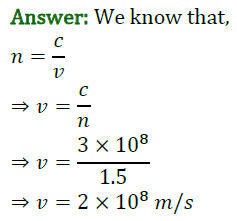
10. The speed of light in a transparent medium is 0.6 times that of its speed in vacuum. What is the refractive index of the medium?
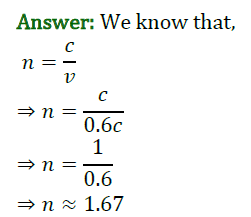
11. State the two laws of reflection of light.
Answer: Laws of reflection of light are:
- The angle of incidence is equal to the angle of reflection.
- The incident ray, the normal to the reflecting surface at the point of incidence and reflected ray from that point, all lies in the same plane.
12. Define and show on a diagram, the following terms relating to a concave mirror:
(i) Aperture
(ii) Radius of curvature
Answer: (i) The diameter of the reflecting surface of the mirror is called aperture.
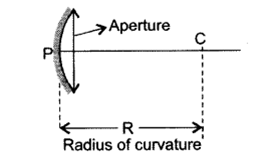
(ii) The radius of the sphere of which the reflecting surface of the spherical mirror forms a part is called the radius of curvature of the mirror.
13. Define the focus of a concave mirror. If the radius of curvature of a convex mirror is 30 cm, what would be its focal length?
Answer: The point on the principal axis where all the rays parallel to it meet after reflection is called focus. Since, R = 30 cm and f=R/2 we have, f = +15 cm for a convex mirror.
14. Distinguish between a real and a virtual image of an object. What type of image is formed (i) by a plane mirror, (ii) on a cinema screen?
Answer: If light rays after reflection converge to a point to form an image on its own, it is called a real image. If they are diverging, then they form a virtual image. Real image can be obtained on a screen, while a virtual image cannot be.
(i) Plane mirror forms virtual image.
(ii) On cinema screen, real image is formed.
15. Define ‘refractive index of a transparent medium.’ What is its unit? Which has a higher refractive index, glass or water?
Answer: The ratio of the speed of light in the free space (c) to the speed of light in given medium (ѵ) is called its refractive index.
n=c/ѵ
It has no unit. Glass has more refractive index than water.
16. Draw a ray diagram and also state the position, the relative size and the nature of image formed by a concave mirror when the object is placed at the centre of curvature of the mirror.

17. A ray of light travelling in air enters obliquely into water. Does the light ray bend towards or away from the normal? Why? Draw a ray diagram to show the refraction of light in this situation.
Answer: Light bends towards the normal because water is denser than air.
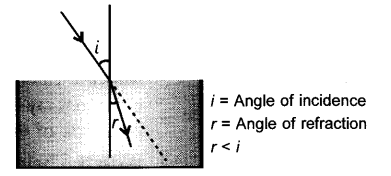
The ray bends towards the normal because it has to travel with a lesser speed in water but with shorter time.
18. (a) “The refractive index of diamond is 2.42”. What is the meaning of this statement?
(b) Name a liquid whose mass density is less than that of water but it is optically denser than water.
Answer: (a) This means that the ratio of speed of light in air and the speed of light in diamond is equal to 2.42. (b) Kerosene
19. With the help of a ray diagram explain why a convex mirror is preferred for rear view mirrors in motor cars.
Answer: (i) It always forms a virtual, erect and diminished image.
(ii) The field of view increases while using a convex mirror as shown.
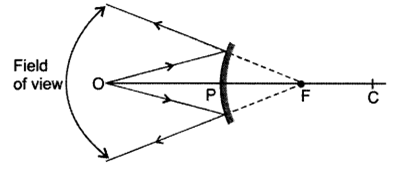
20. What is understood by lateral displacement of light? Illustrate it with the help of a diagram. List any two factors on which the lateral displacement of a particular substance depends.
Answer: Lateral displacement is the perpendicular distance between the incident ray produced and the emergent ray. Lateral displacement in the diagram is BL. The lateral displacement depends on the thickness of the slab, the incident and refraction angles.
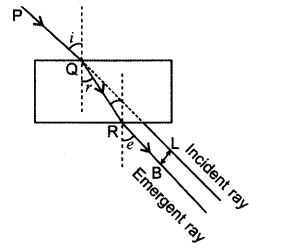
21. Draw the ray diagram and also state the position, relative size and nature of the image formed by a concave mirror when the object is placed between its centre of curvature, C and focus, F.
Answer:
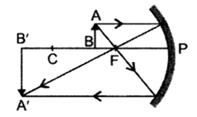
Position of object: Between F and C
Position of image: Beyond C
Nature of image: Real, inverted and enlarged.
22. If a light ray IM is incident on the surface AB as shown, identify the correct emergent ray.
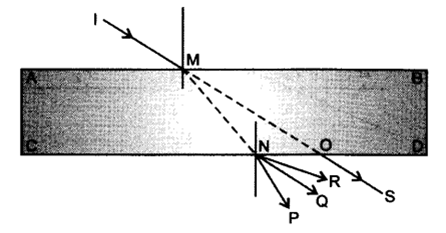
Answer: Ray NQ, as it has to be parallel to ray OS.
23. The refractive indices of four media A, B, C and D are given in the following table:
| Medium | A | B | C | D |
| Refractive Index | 1.33 | 1.50 | 1.52 | 2.40 |
If light, travels from one medium to another, in which case the change in speed will be (i) minimum, (ii) maximum?
Answer: (i) Minimum change is seen as light moves between 1.50 and 1.52, i.e., B and C.
(ii) Maximum change when light moves between 1.33 and 2.40, i.e. A and D.
24. “The refractive index of diamond is 2.42”. What is the meaning of this statement in relation to speed of light?

25. Redraw the given diagram and show the path of the refracted ray:
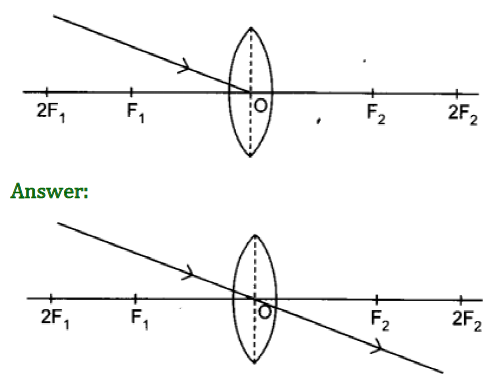
26. Redraw the given diagram and show the path of the refracted ray:
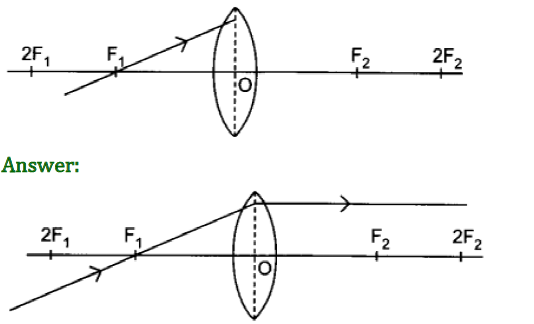
27. Draw the following diagram in your answer book and show the formation of image of the object AB with the help of suitable rays.
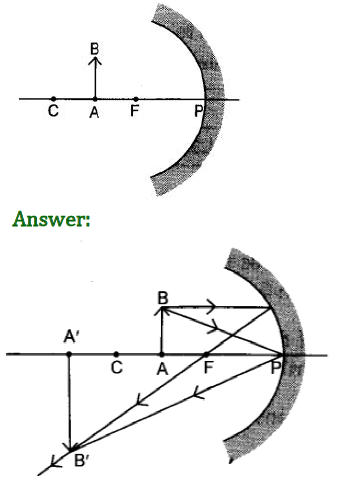
28. Which kind of mirrors are used in the headlights of a motor-car and why?
Answer: Concave mirror, to get the parallel beam of light.
29. Explain with the help of a diagram, why a pencil partly immersed in water appears to be bent at the water surface.
Answer: Light from different points on the pencil, immersed in water refracts and appears to come from a point above the original position.
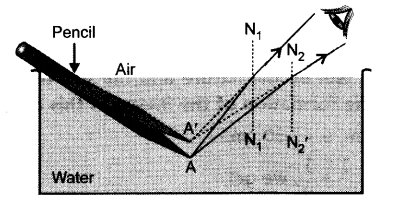
30. Draw ray diagrams to represent the nature, position and relative size of the image formed by a convex lens for the object placed:
(a) at 2F1
(b) between F1 and the optical centre O of lens:
Answer:
(a) At 2F1
Nature: Real, inverted, same size as object.
Position: At 2F
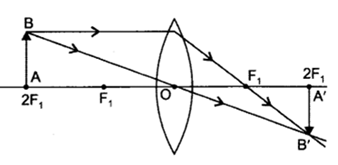
(b) Between F1 and the optical centre O of lens.
Nature: vertical, erect, enlarged
Position: On the same side of the lens.
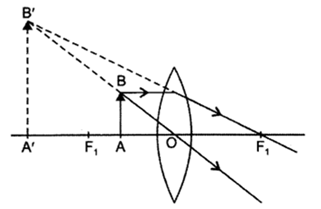
31. A ray of light, incident obliquely on a face of a rectangular glass slab placed in air, emerges from the opposite face parallel to the incident ray. State two factors on which the lateral displacement of the emergent ray depends.
Answer: Lateral displacement depends on the:
- angle of incidence,
- thickness of slab, and
- refractive index of the material. (any two)
32. Redraw the diagram given below in your answer book and show the direction of the light ray after reflection from the mirror.
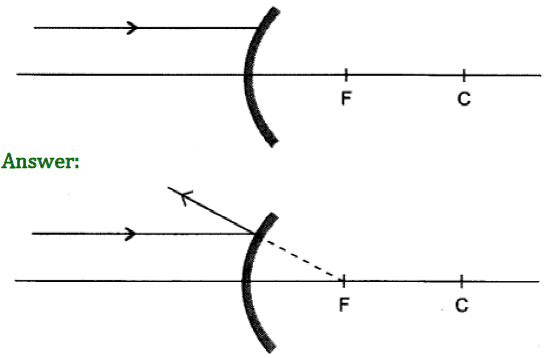
33. Redraw the diagram given below in your answer book and show the direction of the light ray after reflection from the mirror.
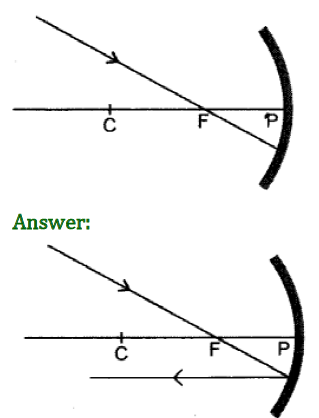
34. Redraw the diagram given below in your answer book and show the direction of the light ray after reflection from the mirror.
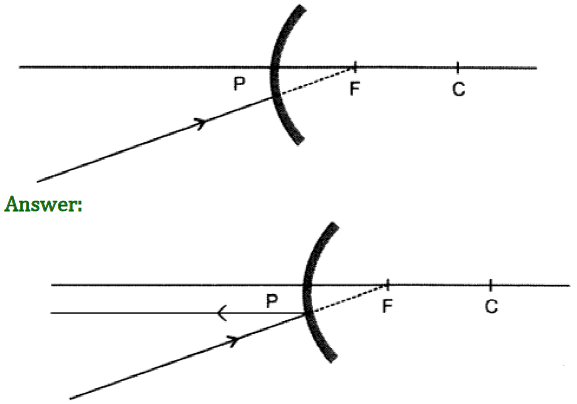
35. Redraw the diagram given below in your answer book and show the direction of the light ray after refraction from the lens.
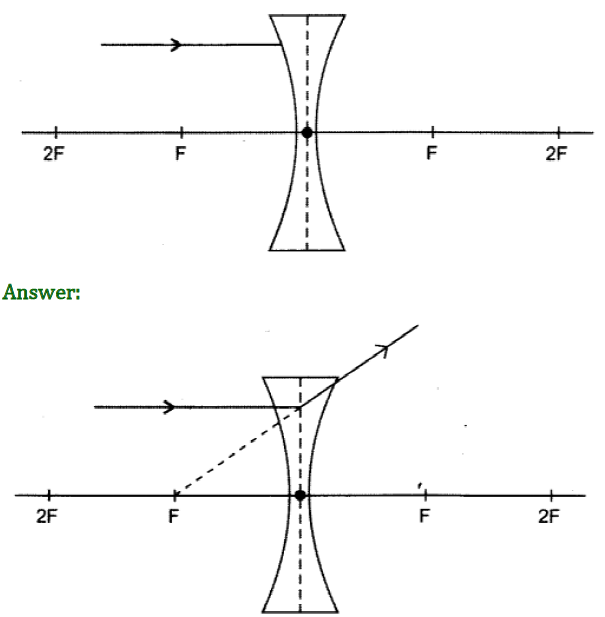
36. Why does a ray of light bend when it travels from one medium into another?
Answer: Due to change in velocity in the medium and to reduce the time taken to travel the same.
37. Redraw the diagram given below in your answer book and show the direction of the light ray after refraction from the lens.
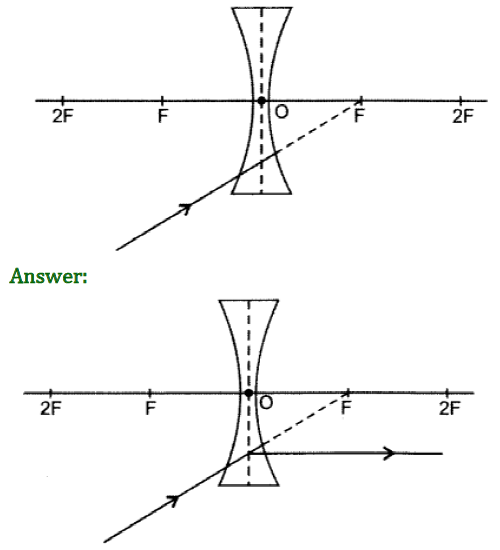
38. What is the minimum number of rays required for locating the image formed by a concave mirror for an object. Draw a ray diagram to show the formation of a virtual image by a concave mirror.
Answer: Two rays.
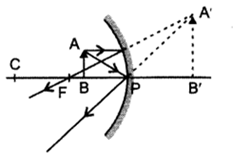
39. The refractive index of water is 1.33 and the speed of light in air is 3 × 108 m/s. Calculate the speed of light in water.
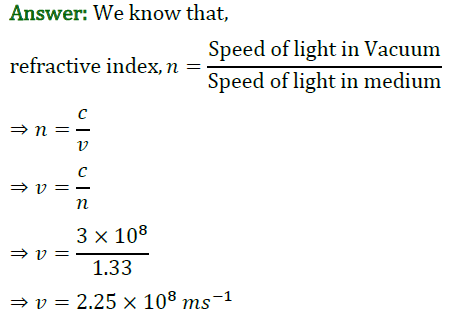
40. The refractive index of glass is 1.50 and the speed of light in air is 3 × 108 m/s. Calculate the speed of light in glass.
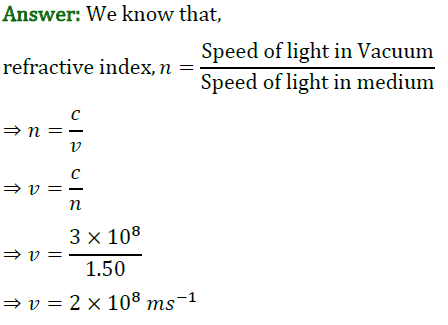
41. For which position of the object does a convex lens form a virtual and erect image? Explain with the help of a ray diagram.
Answer: When the object is placed between the focus and the optical centre, a virtual and erect image is formed.

42. An object 2 cm in size is placed 30 cm in front of a concave mirror of focal length 15 cm. At what distance from the mirror should a screen be placed in order to obtain a sharp image? What will be the nature and the size of the image formed? Draw a ray diagram to show the formation of the image in this case.
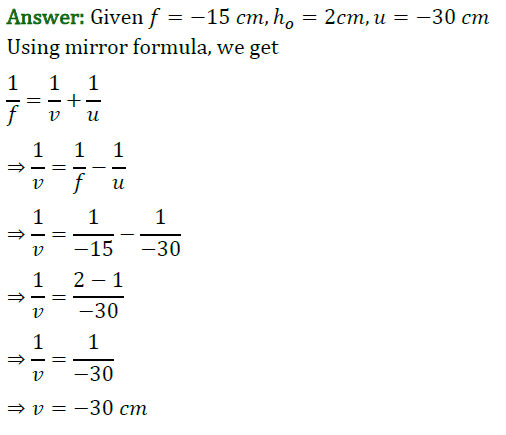
So, screen should be placed at a distance of 30 cm on the same side of the object in order to obtain a sharp image.
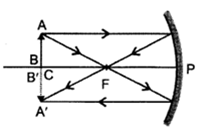
Since, |v| = |u| = 2f, it means that the object is placed at the centre of curvature (C) of a concave mirror, the image formed is at the centre of curvature, real and inverted and of the same size as the object.
43. An object 2 cm high is placed at a distance of 64 cm from a white screen. On placing a convex lens at a distance of 32 cm from the object it is found that a distinct image of the object is formed on the screen. What is the focal length of the convex lens and size of the image formed on the screen? Draw a ray diagram to show the formation of the image in this position of the object with respect to the lens.
Answer: Since, object-screen distance is double of object-lens separation, the object is at a distance of 2f from the lens and the image should be of the same size of the object.
So, 2f = 32
⇒ f = 16 cm
Height of the image = height of the object = 2 cm
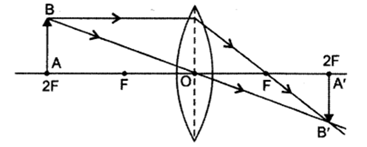
44. A convex lens has a focal length of 10 cm. At what distance from the lens should the object be placed so that it forms a real and inverted image 20 cm away from the lens? What would be the size of the image formed if the object is 2 cm high? With the help of a ray diagram show the formation of the image by the lens in this case.
Answer: f = +10 cm, v = +20 cm as image is real and inverted. Height of the object = 2 cm. (Say +ve)
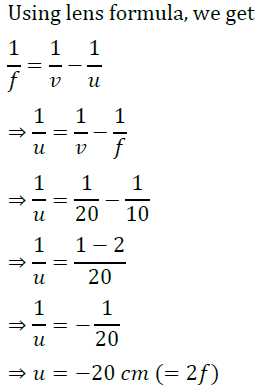
Object is placed at 2F, image is also formed at 2F on the other side of the lens. So, image will be of the same size as the object as |u| = |v| and, therefore the height of the image will be 2 cm.

45. An object is placed between infinity and the pole of a convex mirror. Draw a ray diagram and also state the position, the relative size and the nature of the image formed.

46. In an experiment with a rectangular glass slab, a student observed that a ray of light incident at an angle of 55° with the normal on one face of the slab, after refraction strikes the opposite face of the slab before emerging out into air making an angle of 40° with the normal. Draw a labelled diagram to show the path of this ray. What value would you assign to the angle of refraction and angle of emergence?
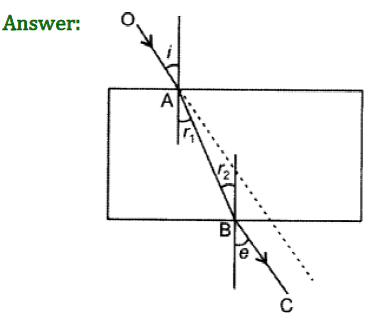
Here,
OA = incident ray
i = angle of incidence = 55°
Given, r2 = 40°
r1 and r2 are alternate interior angles,
So, angle of refraction = 40°
Since, the emergent ray is parallel to the incident ray, the angle of emergent must be equal to angle of incidence , i.e., ∠e = ∠i = 55°
47. At what distance should an object be placed from a convex lens of focal length 18 cm to obtain an image at 24 cm from it on the other side. What will be the magnification produced in this case?
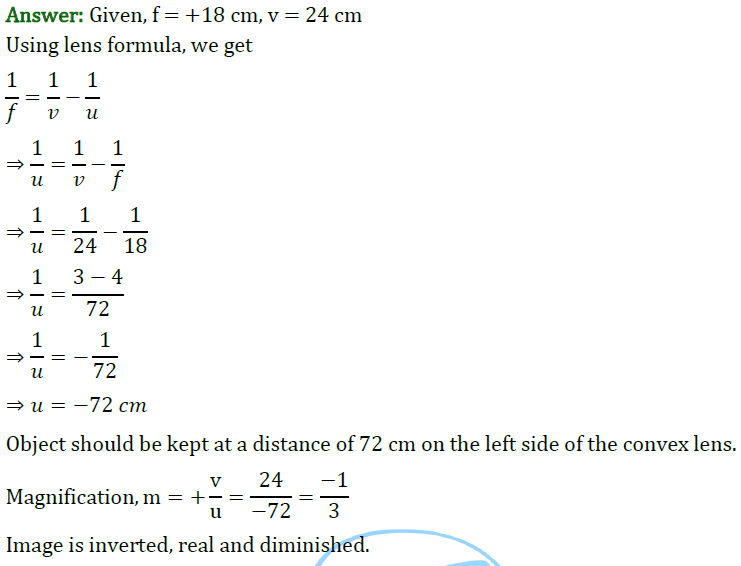
48. How far should an object be placed from a convex lens of focal length 20 cm to obtain its image at a distance of 30 cm from the lens? What will be the height of the image if the object is 6 cm tall?
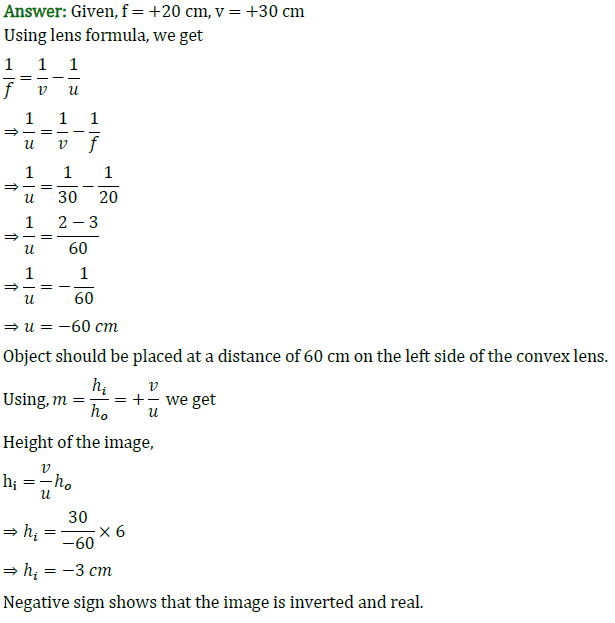
49. The image of an object placed at 60 cm in front of a lens is obtained on a screen at a distance of 120 cm from it. Find the focal length of the lens. What would be the height of the image if the object is 5 cm high?
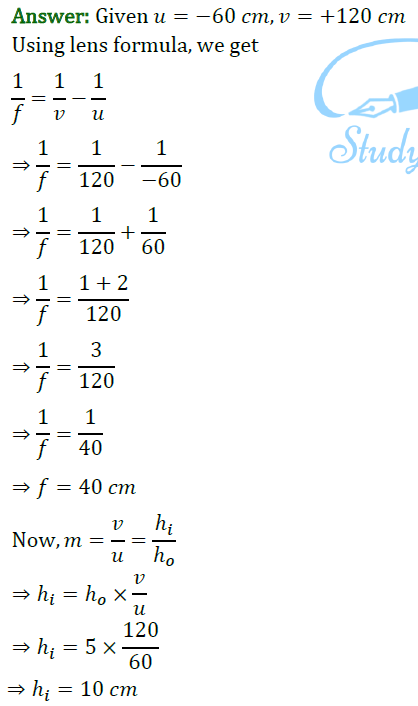
50. What is the principle of reversibility of light? Show that the incident ray of light is parallel to the emergent ray of light when light falls obliquely on a side of a rectangular glass slab.
Answer: The final path of the ray of light after reflections or refraction is reversed; the ray retraces its entire path. This principle is called reversibility of light.
For rectangular glass slab,
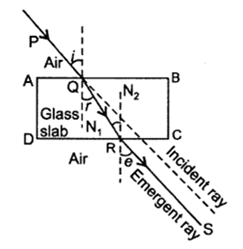
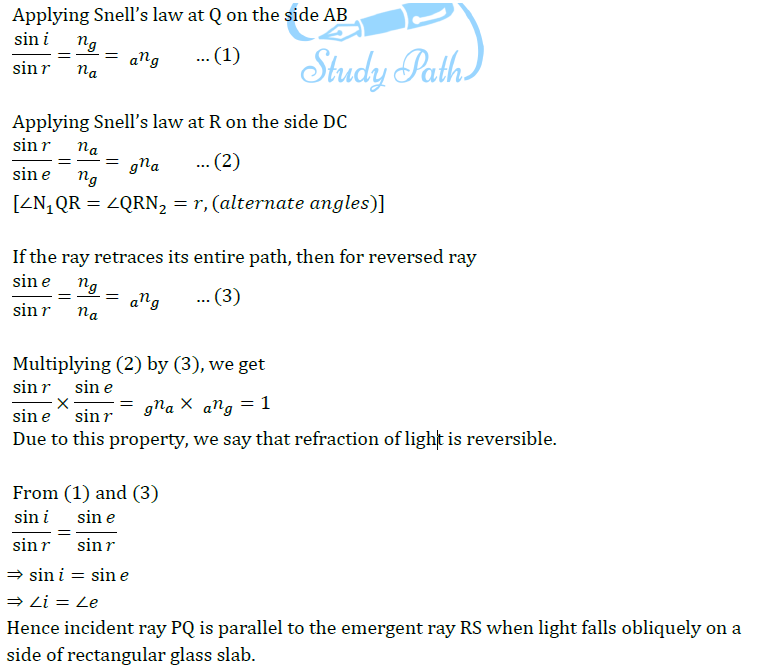
51. A concave lens has focal length of 20 cm. At what distance from the lens a 5 cm tall object be placed so that it forms an image at 15 cm from the lens? Also calculate the size of the image formed.
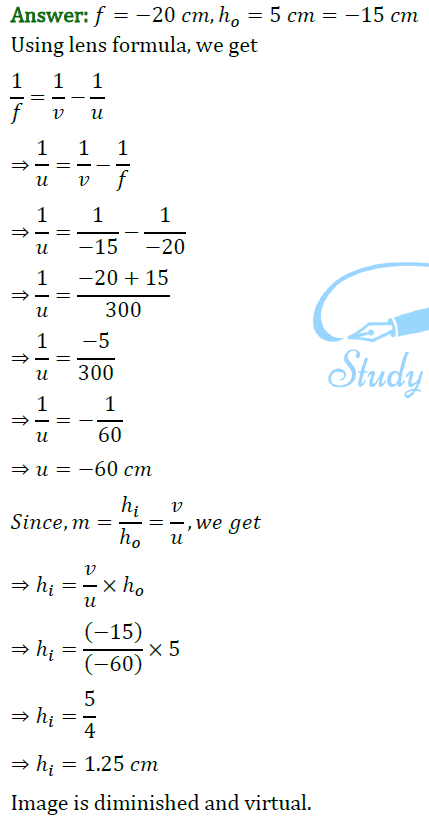
52. Draw the ray diagram in each case to show the position and nature of the image formed when the object is placed:
(i) at the centre of curvature of a concave mirror
(ii) between the pole P and focus F of a concave mirror
(iii) in front of a convex mirror
(iv) at 2F of a convex lens
(v) in front of a concave lens
Answer:
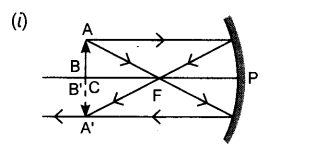
Nature of image: Real, inverted and same size image is formed at the centre of curvature.
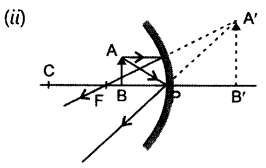
Nature of image: Virtual, enlarged and erect image is formed behind the mirror.
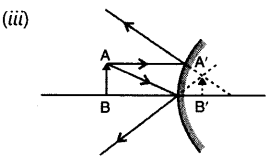
Nature of image: Virtual, erect and diminished, image is formed behind the mirror.
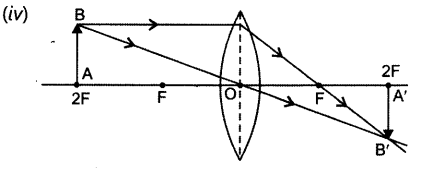
Nature of image: Real, inverted and size to size, image is formed at 2F on the other side of lens.
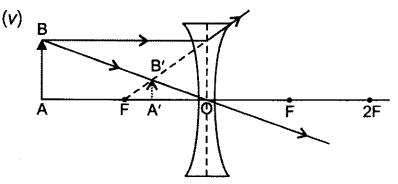
Nature of image: Virtual, erect and diminished image is formed between O and F on the same side of object.
53. (a) It is desired to obtain an erect image of an object, using a concave mirror of focal length 20 cm.
(i) What should be the range of distance of the object from the mirror?
(ii) Will the image be bigger or smaller than the object?
(iii) Draw a ray diagram to show the image formation in this case.
(b) One half a convex lens of focal length 20 cm is covered with a black paper.
(i) Will the lens produce a complete image of the object?
(ii) Show the formation of image of an object placed at 2F1 of such covered lens with the help of a ray diagram.
(iii) How will the intensity of the image formed by half-covered lens compare with non-covered lens?
Answer:
(a) (i) Range of the object distance is 0 to 20 from the pole.
(ii) Image will be bigger than the object
(iii) Ray diagram:
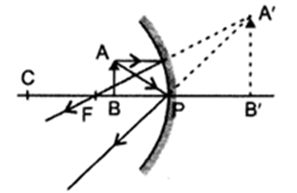
(b) (i)Yes, complete image will be formed.
(ii)
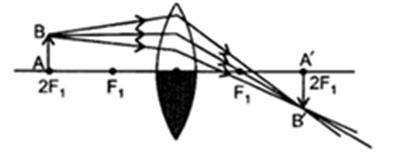
(iii) Intensity will be reduced as the light failing on the lower (covered) portion will not reach the position of image.
54. (a) If the image formed by a lens is diminished in size and erect, for all positions of the object, what type of lens is it?
(b) Name the point on the lens through which a ray of light passes undeviated.
(c) An object is placed perpendicular to the principal axis of a convex lens of focal length 20 cm. The distance of the object from the lens is 30 cm. Find (i) the position (ii) the magnification and (iii) the nature of the image formed.
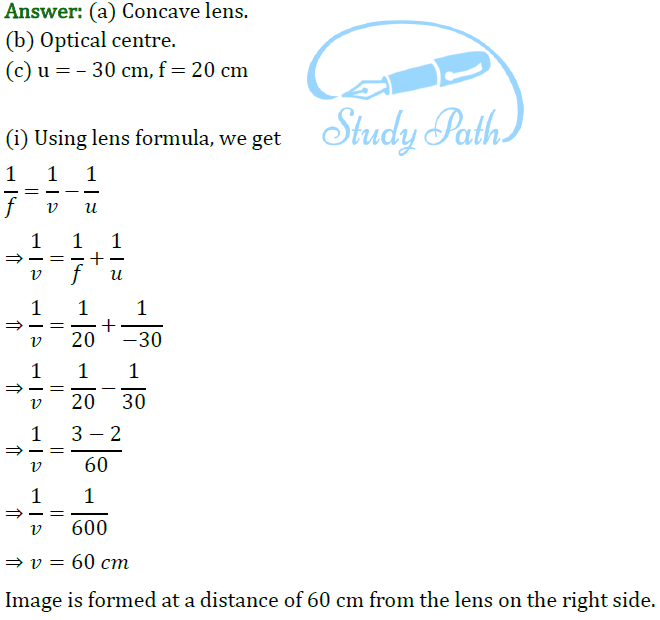
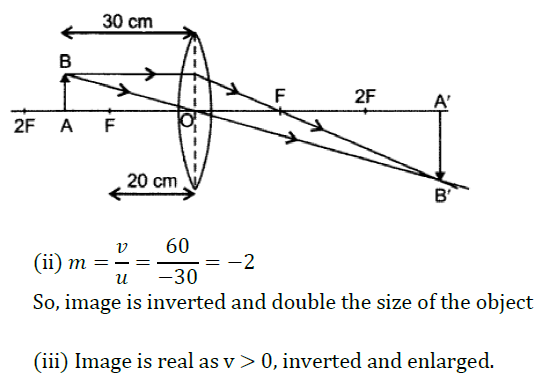
55. (a) What is meant by ‘power of a lens’?
(b) State and define the S.I. unit of power of a lens.
(c) A convex lens of focal length 25 cm and a concave lens of focal length 10 cm are placed in close contact with each other. Calculate the lens power of this combination.
Answer: (a)The ability of a lens to coverage or diverge the ray of light after refraction is called Power (P) of the lens. It is defined as the reciprocal of the focal length, i.e., P = 1/f.
(b) The SI unit of power of a lens is ‘dioptre’. A lens of focal length 100 cm has a power of 1 dioptre, i.e., 1 dioptre = 1m‒1
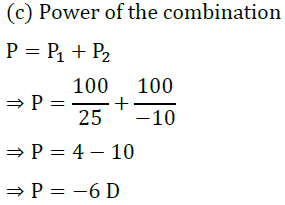
56. (а) Draw a ray diagram to show the formation of image of an object placed between infinity and the optical centre of a concave lens.
(b) A concave lens of focal length 15 cm forms an image 10 cm from the lens. Calculate
(i) the distance of the object from the lens.
(ii) the magnification for the image formed.
(iii) the nature of the image formed.
Answer: (a) Image formation when the object is at any position between infinity and optical centre:
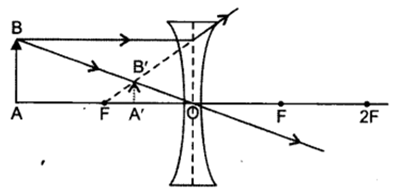
Position of image: Between F and optical centre.
Nature of image: Virtual, erect and diminished.
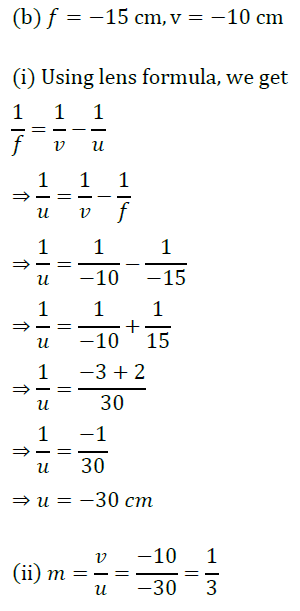
(iii) m is +ve, so image is erect. v is -ve so image is virtual. As m < 1, image is diminished.
57. (a) Under what condition will a glass lens placed in a transparent liquid become invisible?
(b) Describe and illustrate with a diagram, how we should arrange two converging lenses so that a parallel beam of light entering one lens emerges as a parallel beam after passing through the second lens.
(c) An object is placed at a distance of 3 cm from a concave lens of focal length 12 cm. Find the (i) position and (ii) nature of the image formed.
Answer: (a) When the refractive index of glass lens becomes equal to the refractive index of transparent liquid, the glass lens will become invisible.
(b) Parallel beam converges at focus of the first lens and emerges parallel as it is at the focus of second lens.
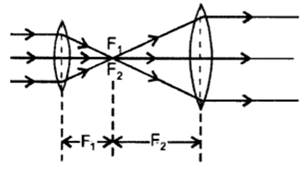
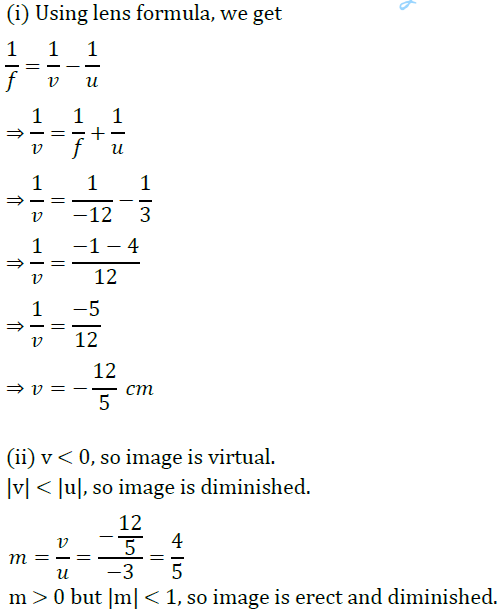
58. (a) With the help of a ray diagram explain why a concave lens diverges the rays of a parallel beam of light.
(b) A 2.0 cm tall object is placed perpendicular to the principal axis of a concave lens of focal length 15 cm. At what distance from the lens, should the object be placed so that it forms an image 10 cm from the lens? Also find the nature and the size of image formed.
Answer: (a) When a parallel beam of light incident on a front face of concave lens, each ray of light will refract towards the normal to the surface as it moves from rarer to denser medium and travels in a straight line inside the lens until it reaches the ‘ back face of the lens. At the back face boundary, each ray of light will again refract and bend away from the normal to the surface as it moves from denser to rarer medium. The course of ray of light is shown in the following figure.
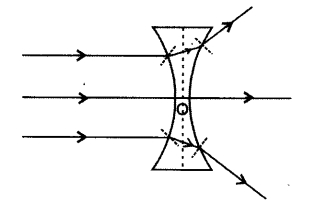
Thus, because of the concave shape of both the faces, the double concave lens diverge the rays of parallel beam of incident light.
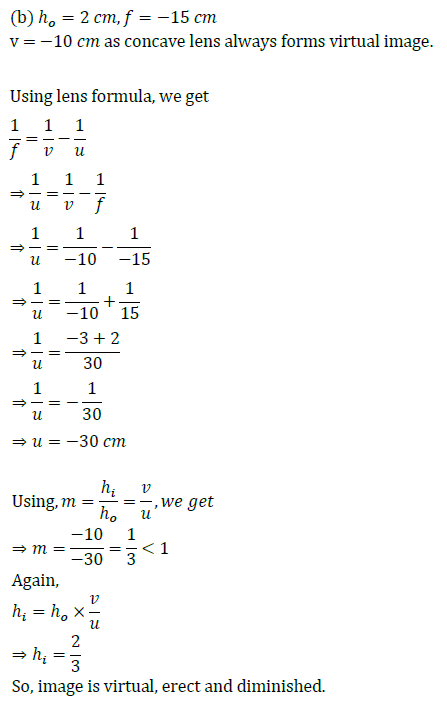
59. List four properties of the image formed by a plane mirror.
Answer: Properties of image formed by a plane mirror:
- It is always virtual and erect.
- Its size is equal to that of the object.
- It is formed at the same distance behind the mirror as the object is in front of the mirror.
- It is laterally inverted.
60. List four properties of the image formed by a convex mirror.
Answer: Properties of image formed by a convex mirror:
- It is always formed behind the mirror, between the pole and its focus.
- It is always virtual and erect.
- Its size is always smaller than the object.
- Magnification is always positive.
61. List four properties of the image formed by a concave mirror, when object is placed between focus and pole of the mirror.
Answer:
- The image is formed behind the mirror.
- It is enlarged, he. magnified.
- It is virtual.
- It is erect.
62. To instruct a ray diagram, we use two light rays which are so chosen that it is easy to know their directions after refraction from the lens. List these two rays and state the path of these rays after refraction. Use these two rays to locate the image of an object placed between ‘F and ‘2F of a convex lens.
Answer: Two rays choose for refraction:
(i) A ray of light parallel to the principal axis.
(ii) A ray of light passing through the optical centre of a lens.
Path of these rays after refraction:
In case of convex lens, the first ray will pass through the principal focus on the other side of the lens.
In case of concave lens, the first ray will
(a) appear to diverge or
(b) appear to come from the principal focus positioned on the same side of the object.
The second ray emerge from the lens without any deviation in the path.
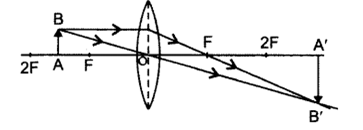
63. State the type of mirror preferred as (i) rear view mirror in vehicles, (ii) shaving mirror. Justify your answer giving two reasons in each case.
Answer: (i) Convex mirror (ii) Concave mirror
Justification:
(i) Convex mirror is used as a rear view mirror because:
(a) it gives a wider field of view as it is curved outwards and
(b) it produces erect and diminished image of the traffic behind the driver of the vehicle.
(ii) Concave mirror is used as a shaving mirror to see a large size image of the face. When the object lies in between pole and principal focus of a concave mirror, it forms a virtual, erect and enlarged image behind it.
64. The image of a candle flame placed at a distance of 45 cm from a spherical lens is formed on a screen placed at a distance of 90 cm from the lens.
Identify the type of lens and calculate its focal length. If the height of the flame is 2 cm, find the height of its image.
Answer: Nature of spherical lens = convex lens
Given: u= -45 cm, v = +90 cm, ho = 2cm
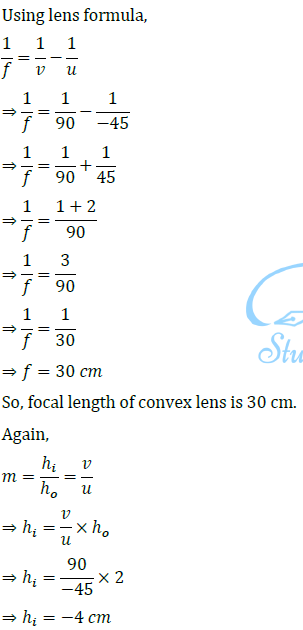
So, height of image is 4 cm. Negative sign indicates that it is formed below the principal axis.
65. A 4 cm tall object is placed perpendicular to the principal axis of a convex lens of focal length 24 cm. The distance of the object from the lens is 16 cm. Find the position, size and nature of the image formed, using the lens formula.

Position of image: Image is formed at a distance of 48 cm from the optical centre of the lens on the same side of the object. It is indicated by the negative sign.
Size of image: It is three times the size of object, i.e. 12 cm.
Nature of image: Positive sign in the image height indicates that image is virtual and erect.
66. Name the type of mirror used in the following situations:
(i) Headlights of a car (ii) Rear-view mirror of vehicles (iii) Solar furnace Support your answer with reason.
Answer: Type of mirror used in
(i) Headlights of a car: Concave mirror Concave mirror is used because light from the bulb placed at the focus of it gets reflected and produces a powerful parallel beam of light to illuminate the road.
(iii) Solar furnace: Concave mirror
Concave mirror has the property to concentrate the sunlight coming from sun along with heat radiation at its focus. As a result, temperature at its focus increases and the substance placed at the focal point gets heated to a high temperature.
(ii) Rear view mirror of vehicles: Convex mirror
Convex mirror is used because it always produces a virtual, and erect image whose size is smaller than the object. Therefore it enables the driver to see wide field view of the traffic behind the vehicle in a small mirror.
67. List the sign conventions for reflection of light by spherical mirrors.
Answer: Sign conventions for reflection of light by spherical mirror are:
- The object is always placed to the left of the mirror.
- All the distances parallel to the principal axis are always measured from the pole of the spherical mirror.
- All the distances measured along the direction of incident light (along +ve x-axis), are considered to be positive.
- Those distances measured opposite to the direction of incidence light (i.e. along -ve x-axis), are taken as negative.
- The distances measured in upward direction, i.e. perpendicular to and above the principal axis (along +ve y-axis), are taken as positive.
- The distances measured in the downward direction, (along -ve y-axis), i.e. perpendicular to and below the principal axis are taken as negative.